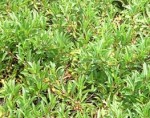Scientific Name: Myoporum sandwicense
Indigenous: South point, Hawaii
Description: Naio papa is a crawling ground cover with dark green, glossy leaves and tiny white flower clusters that emerge from the leaf axis and stems. It has round white fruit that is up to a quarter of an inch in size. When in season hundreds of these tiny fruit can be seen dangling from the underside of each stem. Apparently there are a few different forms of naio papa. This is quite unusual considering that to my knowledge there is only one area in which this plant is found (as you can see in its distribution) and to have three obviously distinct forms growing within this one population is pretty unique. One form has leaves that are a shade or two lighter than the rest, are much broader and appear almost succulent in appearance with marginal serrations near the leaf tip that are a little ‘jagged’. It also has fatter stems that are light green and spread out in a more prostrate manner. The second form has darker leaves that are a little narrower than the first and with much finer marginal serrations. The stems of the second form are also maroon at the tips and tend to not be as prostrate as the first; the flowers also have a pink tinge to them. The third form has dark leaves too but they seem to practically lack the marginal serrations as with the first two and its stems are much woodier in comparison to the first two. This form to me is also the tallest of the different varieties of naio papa.
Distribution: Naio papa is only found on the windswept coast of South Point on the island of Hawai’i. It is pretty cool to see this place because all of the native plants including naupaka (Scaevola sericea), ‘ilima (Sida fallax), and ‘akoko (Chamaecyse celestroides) that are growing in this one area where the naio papa is found have all evolved to take prostrate forms less then 8 inches high, whereas in other areas with perhaps less harsh conditions the same plants are usually about 3-8 feet tall.
Landscape Use: This drought, salt, wind and sun tolerant plant makes a beautiful ground cover that is easy to maintain. Regular watering is o.k. to get the plant established in the ground, but after two to four weeks reduce watering to slow growth and have a more natural look. Plant them in the ground at about two feet apart this will give them adequate space to grow and keep that prostrate look. If planted too close they may compete with each other for space and end up crawling on top one another making them look taller and not so prostrate. As far as bugs go look out for white flies that contribute to the growth of black ‘sooty’ mold which could eventually kill the plant and is an eye sore to look at anyway. Mealy bugs and spider mites can also affect the plant by discoloring and disfiguring the leaves. Treat any of these problems as soon as you see them with either a store bought pesticide or by shooting off the underside of the leaves with a heavy stream of water. Usually once the plant is established and the water reduced to only when needed the bugs have a harder time taking hold. When well maintained, this ground cover will make any landscape look great.
Additional information: Myoporum sandwicense is a highly variable species. Generally it is a shrub or small tree up to about 8-10 ft in height but on occasion you can find certain forms like this one which only reaches a few inches in height to other forms in the upper elevation dry forests that reach heights of over 50 ft.
Naio papa
